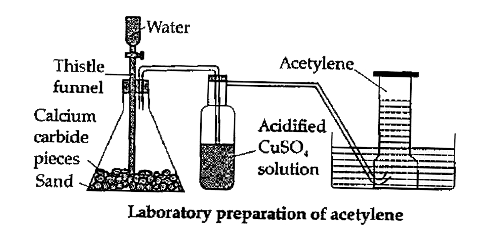Write the equation of the reactions which take place at the cathode and anode when acidified water is electrolysed.
To solve the question regarding the reactions that occur at the cathode and anode during the electrolysis of acidified water, we can break it down into steps:
Step 1: Understand the Electrolysis Process
Electrolysis involves the breakdown of a substance into its components using electricity. In this case, we are looking at acidified water, which contains H⁺ ions from the acid.
Step 2: Identify the Electrodes
In electrolysis, there are two electrodes:
- Cathode: The electrode where reduction occurs (gain of electrons).
- Anode: The electrode where oxidation occurs (loss of electrons).
Step 3: Write the Reaction at the Cathode
At the cathode, the H⁺ ions from the acidified water gain electrons to form hydrogen gas (H₂). The reaction can be written as:
2H++2e−→H2
Step 4: Write the Reaction at the Anode
At the anode, hydroxide ions (OH⁻) are oxidized to form oxygen gas (O₂) and water (H₂O). The reaction can be written as:
4OH−→O2+2H2O+4e−
Step 5: Combine the Reactions
The overall reaction for the electrolysis of acidified water can be summarized as:
- At the cathode: 2H++2e−→H2
- At the anode: 4OH−→O2+2H2O+4e−
Final Equations
1. At the Cathode:
2H++2e−→H2
2. At the Anode:
4OH−→O2+2H2O+4e−
Electrolysis involves the breakdown of a substance into its components using electricity. In this case, we are looking at acidified water, which contains H⁺ ions from the acid.
In electrolysis, there are two electrodes:
- Cathode: The electrode where reduction occurs (gain of electrons).
- Anode: The electrode where oxidation occurs (loss of electrons).
At the cathode, the H⁺ ions from the acidified water gain electrons to form hydrogen gas (H₂). The reaction can be written as:
2H++2e−→H2
At the anode, hydroxide ions (OH⁻) are oxidized to form oxygen gas (O₂) and water (H₂O). The reaction can be written as:
4OH−→O2+2H2O+4e−
The overall reaction for the electrolysis of acidified water can be summarized as:
- At the cathode: 2H++2e−→H2
- At the anode: 4OH−→O2+2H2O+4e−
1. At the Cathode:
2H++2e−→H2
2. At the Anode:
4OH−→O2+2H2O+4e−
Topper's Solved these Questions
- ELECTROLYSISBOOK - ICSECHAPTER - ELECTROLYSISEXERCISE - Additional questions
22 Videos
- ELECTROLYSISBOOK - ICSECHAPTER - ELECTROLYSISEXERCISE - Unit Test Paper 5 - Electrolysis
18 Videos
- ELECTROLYSISBOOK - ICSECHAPTER - ELECTROLYSISEXERCISE - ADDITIONAL QUESTIONS FOR PRACTICE
49 Videos
- CHEMISTRY-2015BOOK - ICSECHAPTER - CHEMISTRY-2015EXERCISE - SECTION-II (40 Marks) Attempt any four questions from this Section.
49 Videos
- METALLURGYBOOK - ICSECHAPTER - METALLURGYEXERCISE - UNIT TEST PAPER 6 - Metallurgy (Select the correct answer from the list A,B,C & given in each statement.)
5 Videos
Similar Questions
Knowledge Check
Which of the following reaction does not take place at cathode ?
AAg+→Ag−e−BFe2+→Fe3++e−CCu2++2e−→CuDAl3+→Al−3e−
Write separate equations for the reactions which take place at the two electrodes when dilute sulphuric acid is electrolysed between two platinum electrodes .
View SolutionGive the reactions occurring at both cathode and anode.
View SolutionName the gas released at cathode when acidulated water is electrolysed.
View Solution
Write the equation to explain the reaction taking place in the above diagram?
View SolutionAn aqueous solution of NaCl is electrolysed with inert electrodes. Write the equations for the reactions taking place at cathode and anode. What happens if AgNO3(aq.) is used instead of NaCl?
View SolutionWrite the chemical equation of the reaction which takes place on burning ethanol in oxygen.
View SolutionWrite the equations for the reactions taking place at the two electrodes (mentioning clearly the name of the electrode ) during the electrolysis of
Acidified copper sulphate solution with copper electrodes .
(ii) Molten lead bromide with (graphite ) electrodes .
View Solution
